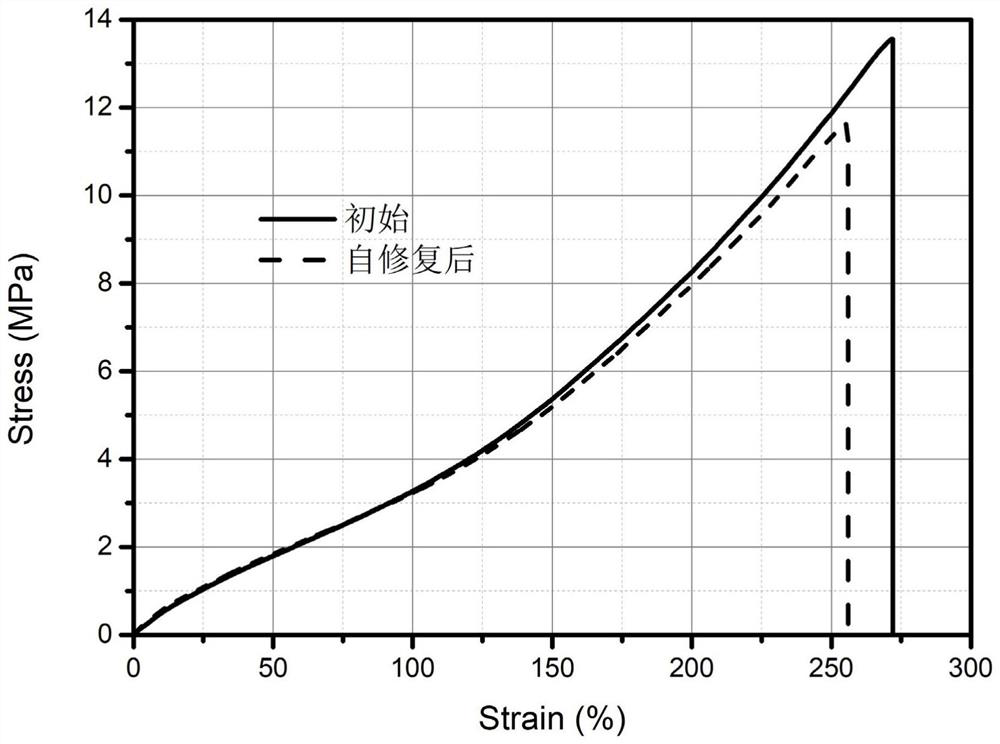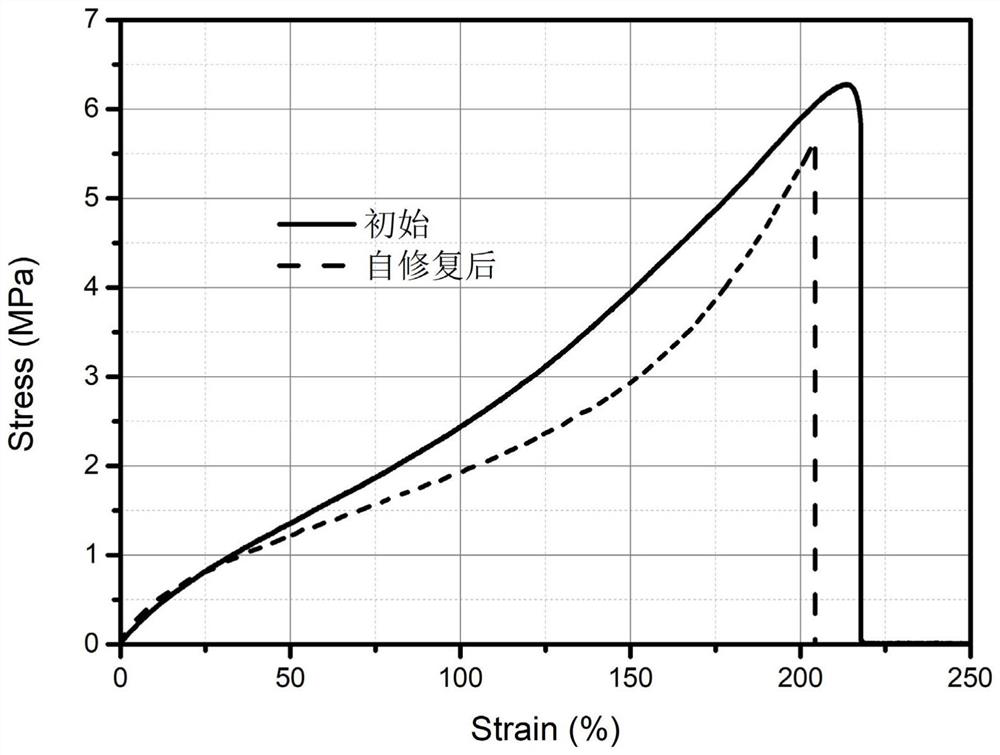Light-cured polyurethane acrylate prepolymer and application thereof in 3D printing
A polyurethane acrylate and 3D printing technology, applied in the field of 3D printing materials, can solve the problems of easy gel failure and limited adjustment range of mechanical properties, and achieve the effects of both mechanical properties and self-repairing properties, novel structure, and application expansion
- Summary
- Abstract
- Description
- Claims
- Application Information
AI Technical Summary
Problems solved by technology
Method used
Image
Examples
Embodiment 1
[0058] 1) 1000g polytetrahydrofuran diol (PTMG, Mw=1000, 1mol) was mixed with 336g hexamethylene diisocyanate (HDI, 2mol), the temperature was raised to 50°C, and 0.89g dibutyltin dilaurate (DBTDL) was added dropwise, The end point of the reaction was determined by titrating the NCO value by the di-n-butylamine method, and the intermediate product C (isocyanate-terminated compound) was obtained.
[0059] 2) 108 g of p-phenylenediamine (1 mol) and 244 g of p-hydroxybenzaldehyde (2 mol) were dissolved in 500 mL of anhydrous chloroform.
[0060] 3) Mix 133.6 g of intermediate product C (0.1 mol) with 63.2 g (0.2 mol) of chain extender A, continue to stir the reaction at 50°C, determine the reaction end point by titrating the NCO value by the di-n-butylamine method, and obtain intermediate product D (Isocyanate terminated intermediate).
[0061] 4) Mix 196.8 g of intermediate product D (0.1 mol) with 23.2 g of hydroxyethyl acrylate (0.2 mol) uniformly, continue stirring the reactio...
Embodiment 2
[0064] 1) Mix 1000g polypropylene glycol (PPG, Mw=1000, 1mol) with 524.7g 4,4-diisocyanate dicyclohexylmethane (HMDI, 2mol), heat up to 60°C, add 1.1g DBTDL dropwise, pass through di-n-butyl The NCO value was determined by amine method to determine the end point of the reaction, and the intermediate product C (isocyanate-terminated compound) was obtained.
[0065] 2) Dissolve 134.1 g of terephthalaldehyde (1 mol) and 122.2 g of ethanolamine (2 mol) in 200 mL of anhydrous chloroform, stir and react at 60° C. for 48 hours under a nitrogen atmosphere, and remove the solvent by rotary evaporation to obtain chain extender B.
[0066] 3) Mix 762.4g of intermediate product C (0.5mol) and 220.3g (1mol) of chain extender B evenly, continue stirring the reaction at 60 ° C, and determine the reaction end point by titrating the NCO value by the di-n-butylamine method to obtain intermediate product D ( isocyanate terminated intermediate).
[0067] 4) Mix 982.7 g of intermediate product D ...
Embodiment 3
[0070] 1) Mix 2000 g of polytetrahydrofuran diol (PPG, Mw=2000, 1 mol) with 336 g of hexamethylene diisocyanate (HDI, 2 mol), raise the temperature to 40° C., add 3 g of DBTDL dropwise, and titrate NCO by the di-n-butylamine method The value determines the end point of the reaction, yielding intermediate C (isocyanate terminated compound).
[0071] 2) Dissolve 134.1 g of terephthalaldehyde (1 mol) and 122.2 g of ethanolamine (2 mol) in 200 mL of anhydrous chloroform, stir and react at 100° C. for 12 hours under a nitrogen atmosphere, and remove the solvent by rotary evaporation to obtain chain extender B.
[0072] 3) Mix 1168g of intermediate product C (0.5mol) with 220.3g (1mol) of chain extender B, continue stirring the reaction at 40°C, determine the reaction end point by titrating the NCO value by the di-n-butylamine method, and obtain the intermediate product D (isocyanate) end capped intermediate).
[0073] 4) Mix 1388.3 g of intermediate product D (0.5 mol) with 130.1 ...
PUM
 Login to View More
Login to View More Abstract
Description
Claims
Application Information
 Login to View More
Login to View More - R&D
- Intellectual Property
- Life Sciences
- Materials
- Tech Scout
- Unparalleled Data Quality
- Higher Quality Content
- 60% Fewer Hallucinations
Browse by: Latest US Patents, China's latest patents, Technical Efficacy Thesaurus, Application Domain, Technology Topic, Popular Technical Reports.
© 2025 PatSnap. All rights reserved.Legal|Privacy policy|Modern Slavery Act Transparency Statement|Sitemap|About US| Contact US: help@patsnap.com



